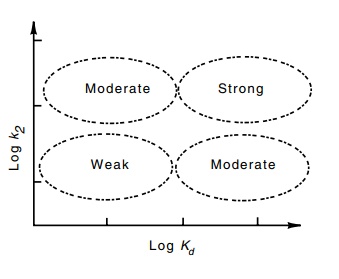Chapter: Genetics and Molecular Biology: RNA Polymerase and RNA Initiation
Roles of Auxiliary Transcription Factors
Roles of Auxiliary Transcription Factors
A strong promoter must have both a high affinity
for polymerase and also a high isomerization rate. The reverse is true of the
weakest promoters. They have low affinity and slow isomerization rates.
Me-dium-activity promoters are weak binders or slow at isomerization (Fig.
4.22). An auxiliary factor that stimulates RNA polymerase can change either the
binding constant or the isomerization rate. The lac operon

Figure
4.22 Requirements onKdand k2 for strong, moderate, and weak
promoter activity.
promoter is stimulated by the cyclic AMP receptor
protein called CAP or CRP. Characterization of the lac promoter with and without CAP shows that the protein primarily
accelerates the isomerization step.
Related Topics